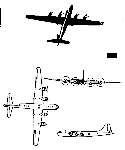





Medium bomber crew training began almost immediately upon receipt of BULLs in 1953 and progressed steadily until extensive long-range night bombing training was noted in late 1954. By 1956, BULL crews were considered proficient in medium altitude bombing under instrument flight conditions. In addition to normal training missions, 4th IR aircraft have been used for a variety of secondary missions. BULLs may have been used against Tibetan dissidents, to shadow intruding CHINAT aircraft, in air defense exercises, and for aerial survey missions. Both BULLs and BADGERs have been associated with special weapons programs. In addition to participating in nuclear tests both as drop aircraft and in air sampling roles, BULLs and BADGERs have been photographed in the air-to-surface missile area of the Shuangchengtzu test center.
While BULL crews were believed to be highly proficient in both day and night operations, the aircraft was highly vulnerable to virtually all air defense weapons, and was withdrawn from active combat service in the 1970s. China retains some 15 of these aircraft in inventory, now used entirely for training and research. One was fitted with a pylon-mounted disk for AEW radar tests.

The Bull is a midwing, four-engine, medium bomber copied from the U.S. B-29A acquired by the USSR in World War II. Bull has two bomb bays centrally located in the fuselage, extending fore and aft of the wing. Defensive armament consists of four turrets located in upper forward, lower forward, lower rear, and tail positions. Although the Soviets have phased it out as an operational bomber, it is still used for this purpose in the Chinese Air Force.
